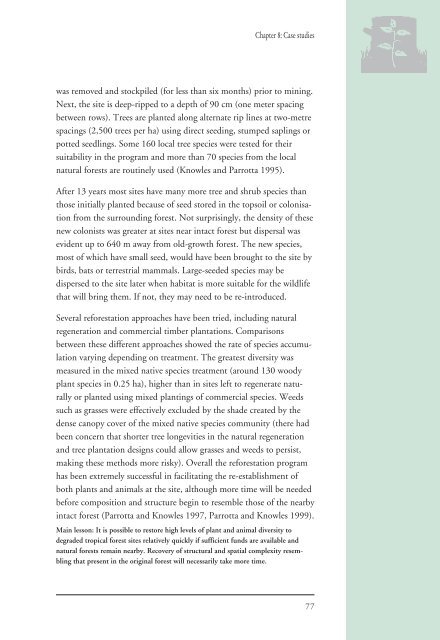Rehabilitation and Restoration Of Degraded Forests (PDF) - IUCN
Rehabilitation and Restoration Of Degraded Forests (PDF) - IUCN
Rehabilitation and Restoration Of Degraded Forests (PDF) - IUCN
Create successful ePaper yourself
Turn your PDF publications into a flip-book with our unique Google optimized e-Paper software.
Chapter 8: Case studies<br />
was removed <strong>and</strong> stockpiled (for less than six months) prior to mining.<br />
Next, the site is deep-ripped to a depth of 90 cm (one meter spacing<br />
between rows). Trees are planted along alternate rip lines at two-metre<br />
spacings (2,500 trees per ha) using direct seeding, stumped saplings or<br />
potted seedlings. Some 160 local tree species were tested for their<br />
suitability in the program <strong>and</strong> more than 70 species from the local<br />
natural forests are routinely used (Knowles <strong>and</strong> Parrotta 1995).<br />
After 13 years most sites have many more tree <strong>and</strong> shrub species than<br />
those initially planted because of seed stored in the topsoil or colonisation<br />
from the surrounding forest. Not surprisingly, the density of these<br />
new colonists was greater at sites near intact forest but dispersal was<br />
evident up to 640 m away from old-growth forest. The new species,<br />
most of which have small seed, would have been brought to the site by<br />
birds, bats or terrestrial mammals. Large-seeded species may be<br />
dispersed to the site later when habitat is more suitable for the wildlife<br />
that will bring them. If not, they may need to be re-introduced.<br />
Several reforestation approaches have been tried, including natural<br />
regeneration <strong>and</strong> commercial timber plantations. Comparisons<br />
between these different approaches showed the rate of species accumulation<br />
varying depending on treatment. The greatest diversity was<br />
measured in the mixed native species treatment (around 130 woody<br />
plant species in 0.25 ha), higher than in sites left to regenerate naturally<br />
or planted using mixed plantings of commercial species. Weeds<br />
such as grasses were effectively excluded by the shade created by the<br />
dense canopy cover of the mixed native species community (there had<br />
been concern that shorter tree longevities in the natural regeneration<br />
<strong>and</strong> tree plantation designs could allow grasses <strong>and</strong> weeds to persist,<br />
making these methods more risky). Overall the reforestation program<br />
has been extremely successful in facilitating the re-establishment of<br />
both plants <strong>and</strong> animals at the site, although more time will be needed<br />
before composition <strong>and</strong> structure begin to resemble those of the nearby<br />
intact forest (Parrotta <strong>and</strong> Knowles 1997, Parrotta <strong>and</strong> Knowles 1999).<br />
Main lesson: It is possible to restore high levels of plant <strong>and</strong> animal diversity to<br />
degraded tropical forest sites relatively quickly if sufficient funds are available <strong>and</strong><br />
natural forests remain nearby. Recovery of structural <strong>and</strong> spatial complexity resembling<br />
that present in the original forest will necessarily take more time.<br />
77

















